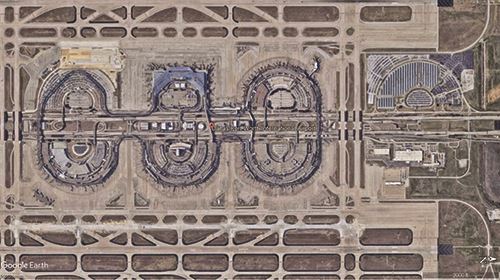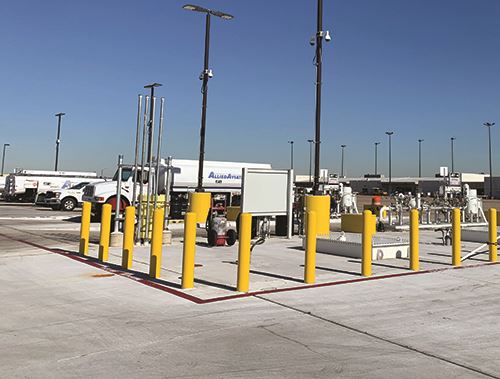Dallas Fort Worth International Airport (DFW) is doing the Infrastructure Shuffle. You know the drill: In order to improve one area, you first have to modify another.
Dallas Fort Worth International Airport (DFW) is doing the Infrastructure Shuffle. You know the drill: In order to improve one area, you first have to modify another.
Originally located on the south end of Terminal D, the airport’s sole fuel truck rack was relocated to a new base on the north end of Terminal A. The move was made last summer to free up space for the expansion of Terminal D, which is slated for completion next year.
While most of the airport’s 164 gates are serviced by an underground fuel hydrant system, refueling trucks are used to fuel aircraft not parked at hydrant-accessible gates.
|
facts&figures Project: Relocating Fuel Truck Reloading Station Location: Dallas Fort Worth Int’l Airport Total Cost: $4.2 million (includes demolition of old station) Strategy: Remove fuel truck filling rack from Terminal D; build new facility near Terminal A Catalyst: Impending extension of Terminal D Timeline: Project initiated in fall 2018; design completed Feb. 2019; key crane permit approved in late April 2019; facility fully operational in mid-Sept. 2019 Design Features: 2 refueler loading skids, each able to pump 400 gal./min.; 10,000-gal. spill containment; 20,000-gal. oil-water separation tank; emergency shut-off system Fuel Facility Owner: DFW Fuel Co. Operator: Allied Aviation Consulting Engineer: Argus Consulting General Contractor: Talon Industries Civil Contractor: Scott Tucker Construction Co. Electrical Contractor: JMEG Electrical Emergency Fuel Shut-off System: Koetter Fire Protection Fuel Skid Fabricator: Garsite Oil/Water Separator: Highland Tank |
DFW Fuel Co., the airport’s fuel consortium, spent $4.2 million to build the replacement station and demolish the old one. Allied Aviation continues to operate the fuel facility.
“American Airlines continues to invest in airport facilities and infrastructure that will strengthen our DFW operations and enable long-term growth,” notes Matthew Duncan, the airline’s senior manager for fuel operations and current head of DFW Fuel. “Fuel facilities are critical to any airport expansion.”
Duncan joined DFW Fuel late in the relocation process, but Argus Consulting provided engineering continuity throughout the project.
The new facility, which opened last September, is practically a mirror image of the facility it replaced; however, its new location presented a fresh set of design challenges. The old station, also designed by Argus, was built in 2008. “We just needed to replace what was there,” explains Seth Newbold, the company’s project engineer for the DFW job.
The new station has two tanker truck filling skids, each able to pump 400 gallons per minute, and a secondary containment structure capable of handling a 10,000-gallon spill. A 20,000-gallon underground separation tank holds oil products for eventual pumping while allowing water to pass to the airport’s wastewater treatment plant. There are also parking spaces for eight additional refueler vehicles—all within the drainage-controlled area.
One upgrade from the previous facility is a state-of-the-art emergency shut-off system. It is a particularly important feature, as Allied monitors the new station from the off-airfield fuel farm. Sensors and closed-circuit cameras facilitate precise control from the remote location. Additionally, the new skids were equipped with a secondary means of overfill protection system that will be required by June 2021.
Tight Timeline
In fall 2018, DFW Fuel and the airport approached Argus to find a location, design the fuel rack and plan the demolition of the existing station. Newbold notes that time was of the essence, because the Terminal D project was moving along quickly.
 By coincidence, there was an old refueler loading station near the corporate aviation terminal that had not been used for about seven years. Moreover, the abandoned station was connected to the airport’s underground fuel pipeline. “We could excavate and tie into the existing 10-inch fuel pipe; but we could not re-use any of the equipment because it was outdated,” explains Newbold. The site had to be reconfigured to enable the parking of the eight refuelers within an expanded containment area.
By coincidence, there was an old refueler loading station near the corporate aviation terminal that had not been used for about seven years. Moreover, the abandoned station was connected to the airport’s underground fuel pipeline. “We could excavate and tie into the existing 10-inch fuel pipe; but we could not re-use any of the equipment because it was outdated,” explains Newbold. The site had to be reconfigured to enable the parking of the eight refuelers within an expanded containment area.
Argus completed the design in February 2019; and Talon Industries, of nearby Arlington, won a three-way bid to serve as the general contractor. All three contractors that bid for the job had previously worked with Argus. Talon has completed a variety of fuel projects at DFW since 1997.
With the airport’s goal for a September switchover looming large, Argus ordered a prefabricated fueling skid system from Garsite and the oil-water separation tank from Highland Tank. Newbold explains that the contractor would typically place such orders later in the process, but pushing ahead saved the team three to four months.
“We were under pressure from the airport to get done as soon as possible,” he recalls. “We spent almost every day from April through June trying to figure out ways to expedite the project.”

Talon created a nontraditional work sequence and added extra manpower to meet the deadline. Some crews worked 60-hour weeks to complete the job on time.
“In the best of worlds, this large tank would be installed well in advance. Then crews would put the utilities on top of that, and then start the civil work,” explains Keith Muskrat, the project manager from Talon. “We had to totally re-sequence the work to be able to accommodate our accelerated schedule. They did a fantastic job.”
Crews started pouring concrete on the perimeter to facilitate timely installation of the underground oil separation tank. And the pre-fabricated fueling skids were put in place before the tank piping installation was complete. Once the tank was installed and pipelines were connected, the concrete crews had little time to finish before the deadline.
Newbold notes that the project got off to a slow start because it took the FAA nearly 65 days to approve the permit needed for crews to use a 100-foot crane on the airfield. Typically, the approval time is about 45 days, he adds. The delay was attributed to a backlog caused by the government shutdown in late 2018.
After the permit was secured in late April, work began full-steam. Allied started to use the new facility in early September on a limited, trial basis. Full operations were switched over by mid-September.
Out With the Old
During the second phase of the project, crews demolished the existing refueler loading station and refueler parking area near Terminal D and turned over the site to the terminal extension project contractor. Key tasks included removing the old fueling skids and a 20,000-gallon oil-water separation tank.
 After crews performed limited soil remediation to remove potentially fuel-contaminated soil, the site was turned over in early October. “It was fast-paced to stay out of the way of the Terminal D contractor,” says Muskrat.
After crews performed limited soil remediation to remove potentially fuel-contaminated soil, the site was turned over in early October. “It was fast-paced to stay out of the way of the Terminal D contractor,” says Muskrat.
APR Aviation Partners is the Construction Manager at Risk for the Terminal D expansion. It is a joint venture of Archer Western Construction, Phillips/May Corp. and Reyes Group.
Unfortunately, as APR Aviation Partners excavated the site, crews found contaminated soil.
“We worked in tandem on the site,” Muskrat explains. “The removal crews stayed ahead, so APR could keep moving with their excavation.”

After the additional soil clean-up, the site was turned over to the airport on Oct. 29.
“The whole project was relatively small,” Muskrat observes, “but with any airport job, there are always challenges.”
With the new fuel truck station running smoothly since last fall, construction continues on the extension of Terminal D. That project will support international and domestic operations by adding 150,000 square feet to the southeast corner of the terminal, with four new gates that are able to serve both domestic and international flights. Officials expect the new space to open in 2021.



